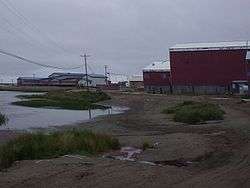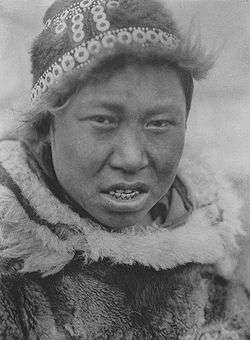Chevak Cup’ik language
| Chevak Cup’ik | |
|---|---|
| Cugtun | |
| Native to | United States |
| Region | Central Alaska (Chevak) |
| Ethnicity | Cup'ik |
|
Eskimo–Aleut
| |
| Latin | |
| Language codes | |
| ISO 639-3 | – |
Linguist list |
esu-hoo |
| Glottolog | None |
Chevak Cup’ik or just Cup’ik (and sometimes Cugtun) is a subdialect of Hooper Bay–Chevak dialect of Yup'ik spoken in southwestern Alaska in the Chevak (Cup'ik, Cev’aq) by Chevak Cup’ik Eskimos (own name Cup’it or Cev’allrarmuit).[1][2][3] The speakers of the Chevak subdialect used for themselves as Cup'ik (as opposed to Yup'ik), but the speakers of the Hooper Bay subdialect used for themselves as Yup'ik (not Cup'ik), as in the Yukon-Kuskokwim dialect.
The Central Alaskan Yupik who in the village of Chevak call themselves Cup'ik (plural Cup'it), whereas those who live on Nunivak Island (Nuniwar in Nunivak Cup'ig, Nunivaaq in Central Yup'ik) call themselves Cup'ig (plural Cup'it), the spelling differences serving as a self-designated cultural identifier between the two groups. In both dialects, the consonant Yup'ik c is pronounced as an English ch. The Cup’ik dialect is readily distinguished from Yup’ik in the pronunciation of Yup'ik "y" sounds as "ch" sounds (represented by the letter "c"), and by some fundamental differences in the base vocabulary and lexicon.
The oldest fully bilingual person in Chevak is Leo Moses, born in 1933; there are few if any persons born after 1945 who do not speak English.[1]
The first documentation of the Hooper Bay-Chevak dialect (beyond occasional citations) is found in the unpublished notes of Jesuit priests residing ay Hooper Bay and Kashunuk in the 1920s and 1930s. Published recognition of Hooper Bay-Chevak as a morphologically distinct dialect of Yup'ik seems to begin with Michael E. Krauss in 1973,[4] although the fundamental differences between the dialects were common knowledge among native speakers.[1] Cup'ik is a critically threatened language, and English the primary language of everyday communication among most of those with knowledge of the language.
Education

Their unique cultural and linguistic identity has allowed them to form a single-site school district, the Kashunamiut School District, rather than joining a neighboring Yup’ik school district. English and Cup’ik bilingual education is done at this school. There is a tri-language system in Chevak; English, Cup’ik, and a mixture of the two languages.
Before 1950 formal education for students in Chevak took place in the Qaygiq[5] (semi-underground men's community house), and in the homes of the people.[6]
Vocabulary comparison
The comparison of some words in the two dialects.
| Yukon-Kuskokwim Yup’ik | Chevak Cup’ik | meaning |
| elicaraq (Y) / elitnauraq (K) | elicaraq skuularaq (Cup’ik English mixed language) |
student |
| elicarista (Y) / elitnaurista (K) | elicarta skuularta (Cup’ik English mixed language) |
teacher |
| yugnikek’ngaq | aiparnatugaq | friend |
| yuilquq | cuilquq | the wilderness; tundra |
| nuussiq | caviggaq | knife (not semi-lunar) |
| uluaq | kegginalek | ulu, semi-lunar woman's knife |
| canek | evek | a blade or stalk of grass |
| ellalluk | ivyuk | rain |
Phonology
There are 18 letters used in the Cup’ik alphabet: a c e g i k l m n p q r s t u v w y.[7]
These letters are not used in the Cup’ik alphabet: b d f h j o x z.
- Short vowels: a i u e
- Long vowels: aa ii uu
- Diphthongs: ai ui au iu ua ia
- Stops: p t c k q
- Voiced fricatives: v l y g r w
- Voiceless fricatives: vv ll ss gg rr ww
- Voiced nasals: m [m] n [n] ng [ŋ]
- Voiceless nasals: m [m̥] n [n̥] ng [ŋ̊]
Russian loanwords

The Russian loanwords used in Chevak Cup’ik date from the period of the Russian America (1733–1867).[8]
- caarralaq (< Rus. сахар) 'sugar'
- caayuq (< Rus. чай) 'tea'
- caanik (< Rus. чайник) 'tea kettle'
- cap’akiq ( < Rus. сапоги) 'shoe'
- cass’aq (< Rus. часы) 'clock'
- culunaq (?< Rus. солонина 'salted meat') 'salted fish'
- kalantaassaq (< Rus. карандаш) 'pencil'
- kalmaaniq (< Rus. карман) 'pocket'
- kelipaq (< Rus. хлеб) 'bread'
- luussitaq (< Rus. лошадь) 'horse'
- mass’laq (< Rus. масло) 'butter; margarine'
- missuulleq (< Rus. мешок) 'burlap sack'
- muluk’uuq (< Rus. молоко) 'milk'
- mult’uuq (< Rus. молоток) 'hammer'
- pal’tuuk (< Rus. пальто) 'coat; jacket'
- pelatekaq (< Rus. палатка) 'tent'
- putuskaq (< Rus. подушка) 'pillow'
- spickaq : (< Rus. спичка) 'match'
- tiititsaaq / tiissitsaaq (< Rus. тысяча) 'thousand; one thousand dollars'
- yaassiik : (< Rus. ящик) 'box; cardboard box'
The names of days and months
- erneq day
- Agayuneq ('praying') Sunday
- Pekyun ('movement') Monday
- Aipirin ('next') Tuesday
- Pingayirin ('third') Wednesday
- Citamirin ('fourth') Thursday
- Tallimirin ('fifth') Friday
- Maqineq ('steambath') Saturday
- iraluq month
- Agayuulek ('icicles') January
- Nakrutlek ('accurate shooter') February
- Neqlelek ('white front geese') March
- Tunturalek ('reindeer') April
- Cupun ('breaking river ice') May
- Kaugun ('clubbing fish') June
- Essgun ('newly hatched eggs') July
- Putukuarun ('waddling ducks & geese') August
- Amiirairun ('shedding') September
- Cauyaun ('drumming') (in Chevak) / Ipukaqun (in Hooper Bay) October
- Kanruyauciq ('frost') November
- Angunquyugtuun ('big toe') December
See also
References
- 1 2 3 Woodbury, Anthony Cabot (1981), Study of the Chevak dialect of Central Yup'ik Eskimo. Ph.D. dissertation, University of California, Berkeley.
- ↑ Woodbury, Anthony Cabot (2002). "The word in Cup'ik". In Dixon, R. M. W. and Alexandra Y. Aikhenvald (eds.) Word: A cross-linguistic typology, 79-99. Cambridge: Cambridge University Press.
- ↑ Woodbury, Anthony Cabot (2004). Morphological Orthodoxy in Yupik-Inuit. University of Texas, Austin
- ↑ Krauss, Michael E. (1973). Eskimo-Aleut. current trends in linguistics 10, ed. by Thomas a. Sebeok, 796-902. The Hague: Mouton.
- ↑ Qaygiq (Men’s House) by Dr. John Pingayak
- ↑ Alaskool: Guidebook for Integrating Cup'ik Culture and Curriculum
- ↑ http://www.alaskool.org/projects/chevak/chevak/sound1.htm
- ↑ David A Peterson (1991), Russian loan words in Central Alaskan Yup'ik. Fairbanks, Alaska, April 1991.
External links
- Alaskool: Chevak Cup’ik Glossary
- Alaskool: Guidebook for Integrating Cup'ik Culture and Curriculum
- Kashunamiut School District
- On the Facebook: Cup'ik Word Of The Day - Chevak by Rebecca Nayamin (Cup’ik Language Orthographist)